From the developments in the sector of the low-noise super-linear amplifiers, which in particular are used for the signals with OFDM, are separated two basic chart technology solutions [5]. The first – is so-called “double measure” or Push-Pull- amplifiers (figure 3). The two-channel antiphase gain of signals with the subsequent association of the responses of subchannels in the output adder is the distinctive special feature of this chart technology concept. In this case the suppression of the highest parasitic harmonics in the spectrum of signal occurs. For shaping of antiphase signals at the entrance of amplifier is used special transformer “phase splitter”.
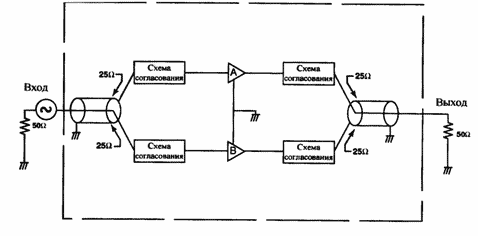
Figure 3. Push-Pull amplifier
The traditional configuration of amplifiers for the SHF-applications is also balance amplifier (figure 4). In it are used 90-degree spacing signal (at the entrance) and coupler (at the output) (loop directional coupler [2]).
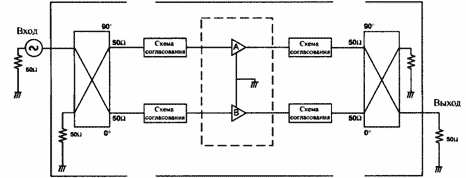
Figure 4. Balance amplifier
Both versions have practically identical characteristics, but for further work selection is made in favor balance amplifier, in view of its simpler practical realization.
As the schematic of the substitution of transistor for the simulation of the amplification stage in the packet Microwave Office is selected the linear circuit of substitution. Final configuration - balance cascade with the general base. As the active circuit element is selected the transistor KT937A. This is the silicic transistor, which adapts for the power amplifiers, the frequency multipliers, and the self-excited oscillators of at frequencies 0.9-5 GHz. This transistor is selected for the design for several reasons. At first, is it correspondence to the advanced requirements, in particular to operating frequency 2.4 GHz. In the second place, presence of this transistor, which will make it possible to subsequently realize project in the prototype and to measure its objective parameters.
For the linear simulation and designing the chains of agreement and loop directional couplers was used the space-model of transistor KT937A (figure 5). Space-model (equivalent circuit Dzhakoletto) - this is the equivalent linear model of transistor, with the aid of which it is possible to estimate the theoretical gain factor, the noise characteristics of transistor, and others. Into the composition of transistor amplifier enter active element (transistor), input and output line-building-out network, feed circuit and grid priming. Furthermore, real power amplifier can contain antiparasitic chains, elements of the stabilization of the regime of the work of transistor on the direct current. As the line-building-out network on entrance and output let us use multilink G-chains [2].
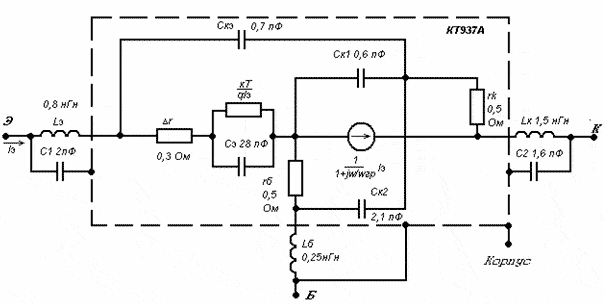
Figure 5. Space-model of transistor KT937A
The loop directional coupler (LDC) [6] is two sections of the transmission line, connected together by two or large number of trains, whose length is equal to quarter wavelength in the line (figure 6). Trains are connected to the line also at a distance of quarter wavelength in the line. With an increase in the number of trains the strip of operating frequencies is enlarged; however, with the number of trains of more than three wave drag of extreme trains become very large. This creates essential difficulties with the fulfillment of such LDC by the methods of integral technology; therefore in the practical devices the number of trains does not exceed three. From the quality of the execution LDC will depend on the characteristics of balance amplifier stage; therefore let us pause in greater detail at the technology of calculation and design of LDC.
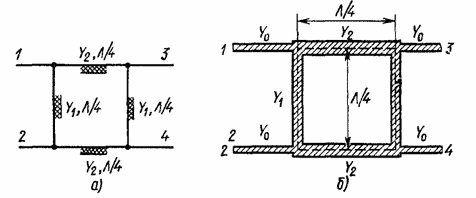
Figure 6. Loop directional coupler
The double-stub directional coupler in this work is used. The procedure of its calculation is the following. The basic parameters of double-stub LDC, which are calculated with the design, are given on the scheme (figure 7).

Figure 7. Loop directional coupler in Microwave Office 5.5
On the schemes:
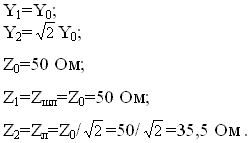
For calculating the circuit parameters we will use the following procedure [7]. The calculation of width micro-strip is conducted through the following formula:

where w - microstrip stub width
Z – wave resistance;
h – thickness of the substrate layer;

– the dielectric constant of the substrate layer.
The calculation of length microstip stub is performed through the simpler formula:

where L - length microstip stub;

– the central wavelength, which will be extended in microstip stub;

– the effective dielectric constant of the substrate layer.
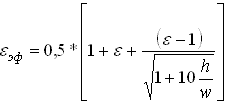
Substituting in these formulas the parameters of the material of the base layer (flan) and the desired values of wave drag (Zs=50 Ohm, Zl=35,5 Ohm), we obtain the following parameters LDC:
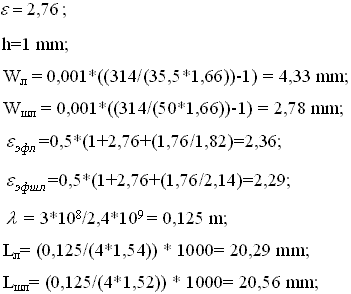
From the obtained parameters it is realized the model of the double-stub directional coupler in the packet Microwave Office 5.5 (figure 8). Subsequently, the obtained diagram will be optimized for the purpose of the achievement of the necessary characteristics of agreement.
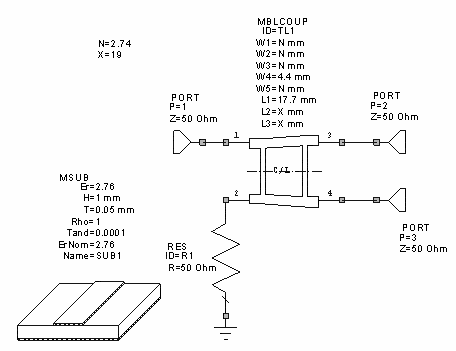
Figure 8. Loop directional coupler in Microwave Office 5.5
As the optimization criterion comes out standing-wave ratio in line (SWR).
Graphs SWR can be built by the standard means of the packet Of microwave Of office 5.5 [8]. Since S11= S22= S33= S44, it is expedient to give only one graph SWR, which was obtained after conducting of the optimization of the parameters of double-stub LDC (figure 9).
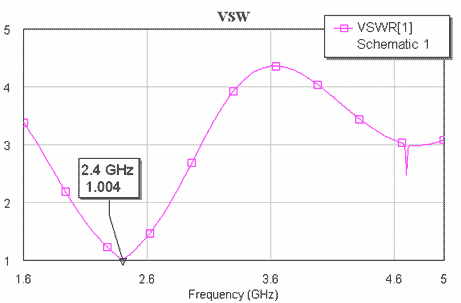
Figure 9. Standing-wave ratio in LDC
As we can see from this graph, at the operating frequency of 2.4 GHz value SWR minimally and composes 1.004, what is sufficiently acceptable result, in view of the fact that this value must be close to 1.
Consequently, the optimized parameters of double-stub LDC are following:
Wl = 4,4 mm;
Ws = 2,74 mm;
Ll = 17,7 mm;
Ls = 19 mm.
The topological diagram of the designed double-stub LDC in full sized depicted in figure 10.

Figure 10. Topological diagram of the designed double-stub LDC
For the total diagram of balance cascade with the input and output line-building-out network and the loop directional couplers it is necessary to obtain a maximally possible value S21 in the range of the frequencies of 2.4-2.483 GHz and is minimally possible S11 in the same range. As limitations they come out the permissible noise factor, and, that is the most important is the stability of cascade in the working frequency band. The results of simulation are given in figures 11- 13.
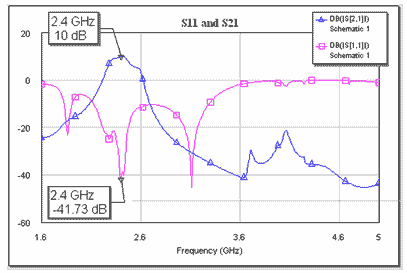
Figure 11. Parameters S11 and S21 for power amplifier
It is possible to see on the obtained graphs that the gain factor (S21), which it was possible to reach at the operating frequency of 2.4 GHz it is equal to 10 dB. This satisfies the requirements stated earlier. The obtained value of reflection coefficient from the entrance (S11= - 41.73 dB) is also more than acceptable and testifies about the high degree of the agreement of amplifier on entrance.
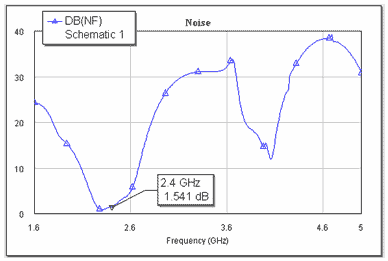
Figure 12. Noise factor for power amplifier
In figure 12 depicted noise characteristics. As we see, at the frequency of 2.4 GHz the value of noise factor is equal to 1.541 dB, what is acceptable value for the amplifiers of this class.
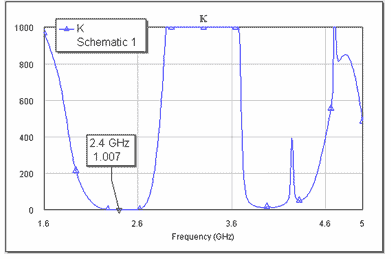
Figure 13. Stability factor for power amplifier
In figure 12 depicted noise characteristics. As we see, at the frequency of 2.4 GHz the value of noise factor is equal to 1.541 dB, what is acceptable value for the amplifiers of this class.
Figure 13 gives basic (k) stability factor. The amplifier stage is considered as the unconditionally steady, when the value of this parameter is the following: k>1. As we can see from the graphs, this condition is satisfied (k=1.007 at the operating frequency of 2.4 GHz), but it at the same time stored up stability is extremely small. Consequently, cascade will be considered steady only with qualitative fulfilling of the chains of agreement.
| 
